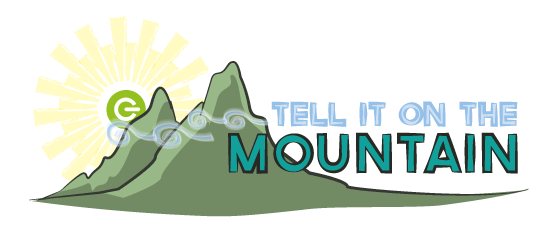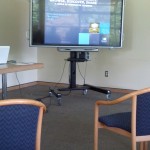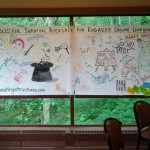This years’ spring Educational Technology User Group (ETUG) conference was held at Simon Fraser University with the theme “Tell it on the mountain: Teaching, Engaging, Learning and Leading ”. I came to the ETUG conference for the first time last year and was really happy to see the collegiality and knowledge sharing which happens within this community. Facilitated by BC Campus, the conference brings together academics, technologists, learners and administrators to discuss issues at their intuitions and areas for collaboration and professional development. Our new Learning Technologies Manager Carl also joined for the conference and was thus fully immersed in the BC edtech community!
Held up on the mountain at Simon Fraser University, on the road in I encountered a coyote who sat with me for a few minutes, a great eagle, and saw a sign warning me about bear sightings! I was intrigued by the remarkably interesting architecture of the campus and the many wonderful learning commons both inside and outside the buildings.
Conference keynote
The conference was keynoted by expert facilitator Nancy White who set the scene nicely for the next couple days with a lively and inspired keynote. Nancy gave us a number of facilitation techniques to think about including the Liberating Structures toolkit which offers a multitude of ways to facilitate discussion within a group.
One lovely quote which Nancy offered us from Peter Block’s 2008 book “Community: The Structure of Belonging” which really sat well with me;
“Every time we gather becomes a model for the future we want to create. This isn’t a protest. This is a process.”
This resonated particularly well with me for this gathering of educational technology change agents. When I attend conferences like this I do hope to replicate or at least get started similar conversations back at VIU. The second part of the quote is also important, as we recognize that these conversations have to happen for change to come and we understand this as a process not a protest.
I value the ETUG conference as it always provides for forward thinking discussion and ideas that can be brought back to our home institution. Now for a roundup of key themes and idea which came out at the conference.
Flipping the classroom
There were a number of presentations on flipping the classroom both from researchers who were investigating the process to instructors who actually had flipped their class. I attended a thoughtful presentation by colleagues at UBC who had flipped the classroom for a professional development course. A model was presented for considering the flipped classroom with a systems thinking approach. One particularly useful notion from this approach was in considering the entire experience of the flipped classroom and what a student experiences holistically.
In the flipped classroom approach an instructor provides much of the knowledge or content transmission online freeing up time face to face (F2F) in the classroom for discussion and questions. In addition to these two modes, the student also experiences a “space between” the online and F2F in which they have time to reflect on the online component and develop their questions. This space between allows for conscious application of new knowledge.
Following the F2F component of the flipped classroom, the student experiences the “space after” a time in which they will hopefully be able to take the knowledge gained and then discussed from the abstract to the concrete for use in the real world.
I found the explicit definition of the space between and the space after useful when thinking about the flipped classroom model. As always effective teaching comes down to well thought through learning design and the flipped classroom means designing for more than just the online and F2F components of the experience. The presenters noted that while the flipped classroom concept is fairly easy to conceptualize, it does take a bit of planning to implement successfully.
Training and development
Royal Roads gave a great presentation on their strategies for developing instructor capacity for Blackboard Collaborate on their campus. As we roll out training for our own campus I was quite interested to hear of the strategies and techniques they had used. The presenters noted that the Blackboard Collaborate help resources were ample, yet they were hard to navigate, as the sheer volume of help resources can be overwhelming at first glance. Royal Roads have thus designed their own pathways through the Collaborate resources which link to specific resources organized in three levels of expertise (beginner, intermediate and expert). The presenters indicated that they would be happy to share the training pathways and I hope to reuse them for our own Collaborate training support documents.
A highlight of the conference for me was the thoughtful presentation delivered by Maristela Petrovic-Dzerdz all the way from Carleton University on Ottawa. Maristela commented on her own journey as an instructional designer helping academics transform their in class courses into online courses with a number of notable reflections.
She reflected on the concept of the lecture versus the lesson; if you consider the way a student studies the piano they typically experience a hands on lesson, whereas in university we often experience a lecture. Now imagine if a student was trained to play the piano by simply experiencing a 90 minute concert. While providing significant inspiration, the student requires much more hands on practice in order to learn to play the piano; this is the philosophy with which Maristela approaches designing elearning.
I loved her analogy of the square peg (in class course); round hole (online course) which she uses to help instructors understand the need for transformation, not simply transferring of a course from in class to online. If you lay the square peg on top of the round hole, you will notice that you need to trim the corners to prepare your material for online, these are the things you may have done in class which simply will not translate to online. Once you have done this also need to fill in the gaps where the circle extends beyond the square; these are the online specific activities and resources required for a good online course. I hope to create an animation or short video which visualizes this analogy for sharing with the community.
Furthermore Maristela reflected on how humbling it can be for instructors when they realize they can replace certain aspects of their teaching with open educational resources, rich media, or other elearning material. Instructors are increasingly finding resources online which can be useful for demonstrating a particular concept or idea and integrating this into their online courses reinforcing the instructor as the guide on the side and not the source of information.
Collaborative services
I was excited to hear about the new WriteAway service being coordinated by BC Campus which allows for crowdsourced academic writing reviews for students. This system allows any student to submit a piece of writing to the WriteAway system and through a shared and collaborative service have their writing reviewed by a reviewer from any one of the participating institutions. The work is submitted into the system electronically and the next available reviewer can review the students’ writing and provide feedback that the student receives electronically through the system. This service is currently being piloted with a select few institutions and I hope we can get VIU involved in the next few months.
Roundup
The final presentation by Michelle Harrison from Thompson Rivers University challenged us to reflect on learning spaces and the conditions in which we do our our own learning. This was a great opportunity to reflect on the space we had shared over the last couple of days and allowed the audience to reflect on how they planned to digest all of the discussions and ideas on their own both during and post conference.
ETUG 2013 was an incredibly worthwhile experience and a fantastic opportunity to connect with educational technology practitioners throughout the province. I always enjoy the many conversations and connecting with colleagues from other institutions. Thanks to BC Campus for failiating and Simon Fraser University for hosting the conference this year.
All of the resources from the conference are available here under a Creative Commons License.








